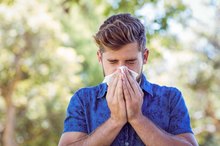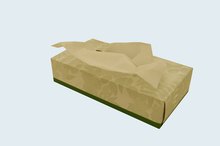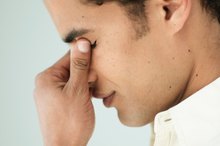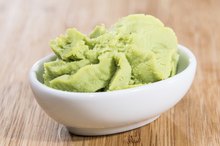What Is Pan Sinus Disease?
**Pan sinus disease, more commonly known as pansinusitis, is the infection of all four of your paranasal sinuses at once 2.
If you are experiencing serious medical symptoms, seek emergency treatment immediately.
** Many people develop it and some even suffer from chronic pan sinus disease.
Although it is not uncommon, it can be a very serious, painful condition. To understand how serious, you must first understand more about the area it affects: the sinuses.
Structure and Function of the Sinuses
Your paranasal sinuses (also called just sinuses) are air-filled spaces or holes in your skull and nasal area. There are four types of sinuses: the maxillary sinuses, the frontal sinuses, the ethemoid sinuses and the sphenoid sinuses. **There is debate over what purpose your sinuses actually serve, but it is generally thought that they increase the resonance of your voice and provide a buffer against blows to your head and face.
They also insulate some sensitive cranial structures from temperature fluctuations, such as your eyes and the roots of your teeth. The paranasal sinuses are also lined with a membrane that secretes antibacterial mucus that protects your nasal cavity from allergens and other irritants that may be inhaled. **
- Your paranasal sinuses (also called just sinuses) are air-filled spaces or holes in your skull and nasal area.
- They also insulate some sensitive cranial structures from temperature fluctuations, such as your eyes and the roots of your teeth.
Causes
Warning Signs and Symptoms of a Dangerous Sinus Infection
Learn More
Pan sinus disease is simply sinusitis or sinus infection in all of your sinus cavities at once.
Sinusitis occurs when the mucus membranes of the parasinus cavities become infected. **It can be caused by either a bacterial or a fungal infection.
** Tooth abscesses, where the bacteria find its way through the mouth to the nasal cavity, can cause sinusitis. Inhaled allergens or irritants can also bring on sinusitis. Nasal blockages can also cause the mucus membranes in your parasinus cavities to malfunction.
- Pan sinus disease is simply sinusitis or sinus infection in all of your sinus cavities at once.
- Tooth abscesses, where the bacteria find its way through the mouth to the nasal cavity, can cause sinusitis.
Symptoms
Some common signs that you may have pan sinus disease are a nasal blockage or discharge. You may also experiences postnasal drip or excessive mucus being produced by your sinuses. Tooth aches or constant painful pressure in the sinus cavities are also symptoms.
Some patients even experience foul breath, a sore throat or a hacking cough when they have pan sinus disease.
Many of these symptoms can be attributed to other conditions, such as dental problems, colds or flu. A good rule of thumb is that, if mucus is involved, it is not about your teeth. And if you have what seems like a cold or flu but lasts longer than three days, it's probably some sort of sinusitis.
If your health care provider suspects pan sinus disease, he may perform a computed tomography scan (also called a CT scan) or X-rays to get a better look at your sinus area. He may go so far as to have your mucus analyzed to determine whether your infection is caused by one microorganism or several.
- Some common signs that you may have pan sinus disease are a nasal blockage or discharge.
- Some patients even experience foul breath, a sore throat or a hacking cough when they have pan sinus disease.
Treatment
What Are the Symptoms of a Sinus Fungal Infection?
Learn More
Once you have been diagnosed with pan sinus disease, your health care provider may prescribe oral antibiotics or corticosteroids to fight off the infection. You will most likely begin to feel better within a few days of taking the medication, but it is very important to finish out the prescription completely to avoid an immediate reoccurrence.
As nasal discharge accumulates in your sinus cavities, the situation becomes more dangerous. Because of the proximity of the sinus cavities to your brain, it is possible for nasal discharge to escape into the brain. In serious cases, an endoscopic sinus surgery will be performed to remove some of the buildup.
This surgery can remove debris or polyps that sometimes form in the sinus area. Afterwards, you will see a marked improvement in breathing and sinus drainage.
- Once you have been diagnosed with pan sinus disease, your health care provider may prescribe oral antibiotics or corticosteroids to fight off the infection.
- You will most likely begin to feel better within a few days of taking the medication, but it is very important to finish out the prescription completely to avoid an immediate reoccurrence.
Prevention
Those who suffer from chronic pan sinus disease can experience symptoms several times a year. **To avoid pan sinus disease, keep yourself hydrated.
** If your sinus mucus membranes are well hydrated, there is less chance that they will become infected.
If you are prone to pan sinus disease, or any type of sinusitis, you should be on the lookout for the familiar symptoms of an oncoming sinus infection 1.
If you think you have one coming on, apply warm compresses to your sinus cavities three times a day for up to five minutes each time. This should break up any mucus blockages and promote healthy circulation.
- Those who suffer from chronic pan sinus disease can experience symptoms several times a year.
- If your sinus mucus membranes are well hydrated, there is less chance that they will become infected.
Related Articles
References
- Symptoms and Treatment of Pan Sinusitis
- What is Pansinusitis?
- Battisti AS, Pangia J. Sinusitis. [Updated 2019 Jun 18]. In: StatPearls [Internet]. Treasure Island (FL): StatPearls Publishing; 2019 Jan-. Available from: https://www.ncbi.nlm.nih.gov/books/NBK470383/
- de Camargo RA, Nicodemo AC, Sumi DV, et al. Facial structure alterations and abnormalities of the paranasal sinuses on multidetector computed tomography scans of patients with treated mucosal leishmaniasis. PLoS Negl Trop Dis. 2014;8(7):e3001. Published 2014 Jul 31. doi:10.1371/journal.pntd.0003001
- Naclerio RM, Bachert C, Baraniuk JN. Pathophysiology of nasal congestion. Int J Gen Med. 2010;3:47–57. Published 2010 Apr 8.
- InformedHealth.org [Internet]. Cologne, Germany: Institute for Quality and Efficiency in Health Care (IQWiG); 2006-. Sinusitis: Overview. 2009 Feb 9 [Updated 2018 Oct 18].Available from: https://www.ncbi.nlm.nih.gov/books/NBK279485/
- Worrall G. Acute sinusitis. Can Fam Physician. 2011;57(5):565–567.
- Ah-See KW, Evans AS. Sinusitis and its management. BMJ. 2007;334(7589):358–361. doi:10.1136/bmj.39092.679722.BE
- Benevides GN, Salgado GA Jr, Ferreira CR, Felipe-Silva A, Gilio AE. Bacterial sinusitis and its frightening complications: subdural empyema and Lemierre syndrome. Autops Case Rep. 2015;5(4):19–26. Published 2015 Dec 30. doi:10.4322/acr.2015.029
- Silveira MLC, Anselmo-lima WT, Faria FM, et al. Impact of early detection of acute invasive fungal rhinosinusitis in immunocompromised patients. BMC Infect Dis. 2019;19(1):310.
- Kwon E, O'Rourke MC. Chronic Sinusitis. [Updated 2018 Nov 18]. In: StatPearls [Internet]. Treasure Island (FL): StatPearls Publishing; 2019 Jan-. Available from: https://www.ncbi.nlm.nih.gov/books/NBK441934/
- D'anza B, Stokken J, Greene JS, Kennedy T, Woodard TD, Sindwani R. Chronic invasive fungal sinusitis: characterization and shift in management of a rare disease. Int Forum Allergy Rhinol. 2016;6(12):1294-1300.
- Benevides GN, Salgado GA Jr, Ferreira CR, Felipe-Silva A, Gilio AE. Bacterial sinusitis and its frightening complications: subdural empyema and Lemierre syndrome. Autops Case Rep. 2015;5(4):19–26. Published 2015 Dec 30. doi:10.4322/acr.2015.029
- Ah-See KW, Evans AS. Sinusitis and its management. BMJ. 2007;334(7589):358–361. doi:10.1136/bmj.39092.679722.BE
- Lee S, Lane AP. Chronic rhinosinusitis as a multifactorial inflammatory disorder. Curr Infect Dis Rep. 2011;13(2):159–168. doi:10.1007/s11908-011-0166-z
- Jiang RS, Huang WC, Liang KL. Characteristics of Sinus Fungus Ball: A Unique Form of Rhinosinusitis. Clin Med Insights Ear Nose Throat. 2018;11:1179550618792254. Published 2018 Aug 3. doi:10.1177/1179550618792254
- Min JY, Tan BK. Risk factors for chronic rhinosinusitis. Curr Opin Allergy Clin Immunol. 2015;15(1):1–13. doi:10.1097/ACI.0000000000000128
- Zhang Z, Adappa ND, Lautenbach E, et al. The effect of diabetes mellitus on chronic rhinosinusitis and sinus surgery outcome. Int Forum Allergy Rhinol. 2014;4(4):315–320. doi:10.1002/alr.21269
- Lin YH, Chang TS, Yao YC, Li YC. Increased Risk of Chronic Sinusitis in Adults With Gastroesophgeal Reflux Disease: A Nationwide Population-Based Cohort Study. Medicine (Baltimore). 2015;94(39):e1642. doi:10.1097/MD.0000000000001642
- Pynnonen MA, Lynn S, Kern HE, et al. Diagnosis and treatment of acute sinusitis in the primary care setting: A retrospective cohort. Laryngoscope. 2015;125(10):2266–2272. doi:10.1002/lary.25363
- Novis SJ, Akkina SR, Lynn S, Kern HE, Keshavarzi NR, Pynnonen MA. A diagnostic dilemma: chronic sinusitis diagnosed by non-otolaryngologists. Int Forum Allergy Rhinol. 2016;6(5):486-90.
- Ah-See KW, Evans AS. Sinusitis and its management. BMJ. 2007;334(7589):358–361. doi:10.1136/bmj.39092.679722.BE
- Blin P, Blazejewski S, Lignot S, et al. Effectiveness of antibiotics for acute sinusitis in real-life medical practice. Br J Clin Pharmacol. 2010;70(3):418–428. doi:10.1111/j.1365-2125.2010.03710.x
- Potter PC, Pawankar R. Indications, efficacy, and safety of intranasal corticosteriods in rhinosinusitis. World Allergy Organ J. 2012;5(Suppl 1):S14–S17. doi:10.1097/WOX.0b013e31823f7216
- Ah-See KW, Evans AS. Sinusitis and its management. BMJ. 2007;334(7589):358–361. doi:10.1136/bmj.39092.679722.BE
- Treating Chronic Sinusitis. Informed Health Online: Institute for Quality and Efficiency in Health Care. https://www.ncbi.nlm.nih.gov/pubmedhealth/PMH0072668/.
- Chow AW, Benninger MS, Brook I, et al. IDSA Clinical Practice Guideline for Acute Bacterial Rhinosinusitis in Children and Adults. Clin Infect Dis. 2012;54(8):e72–e112.
- Hamilos DL. Chronic Rhinosinusitis (Beyond the Basics). UpToDate. https://www.uptodate.com/contents/chronic-rhinosinusitis-beyond-the-basics.
- Radojicic C. Sinusitis. Cleveland Clinic Center for Continuing Education. http://www.clevelandclinicmeded.com/medicalpubs/diseasemanagement/allergy/rhino-sinusitis/.
- Wald ER, Applegate KE, Bordley C, et al. Clinical Practice Guideline for the Diagnosis and Management of Acute Bacterial Sinusitis in Children Aged 1 to 18 Years. Pediatrics. 2013;132(1):e262-80.
Writer Bio
Michaele Curtis began writing professionally in 2001. As a freelance writer for the Centers for Disease Control, Nationwide Insurance and AT&T Interactive, her work has appeared in "Insurance Today," "Mobiles and PDAs" and "Curve Magazine." Curtis holds a Bachelor of Arts in communication from Louisiana State University.









